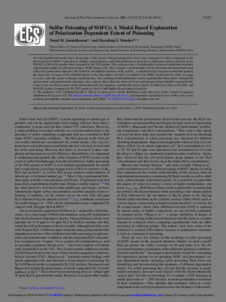Janardhanan, V and Monder, D S
(2014)
Sulfur Poisoning of SOFCs: A Model Based Explanation of Polarization Dependent Extent of Poisoning.
Journal of The Electrochemical Society, 161 (14).
F1427-F1436.
ISSN 0013-4651
![[img]](http://raiithold.iith.ac.in/style/images/fileicons/application_pdf.png)  Preview |
|
PDF (Open access article (CC-BY))
J._Electrochem._Soc.-2014-Janardhanan-F1427-36.pdf
- Published Version
Download (885kB)
|
Abstract
Several experimental studies have shown that, 1) the extent of the poisoning effect due to trace amounts of sulfur compounds in the fuel is lower if a SOFC is operated at a higher current density, and 2) the performance drop due to sulfur poisoning is much lower for Ni-GDC or Ni-ScSZ anodes when compared to Ni-YSZ anodes. This work presents a first principles numerical model that simulates experimental studies of sulfur poisoning on SOFC button cells. The exchange current densities for the electrodes are determined using sulfur-free polarization data for cells fueled by humidified mixtures of H2 and N2. A detailed surface reaction model that predicts the fractional coverage of all adsorbed species at the three phase interface is coupled to the SOFC model and the sulfur coverage is used to alter the anode exchange current density. The resulting model predictions match experimental observations during both galvanostatic and potentiostatic operation. Our analysis shows that the observed lower performance drop at higher current density is due to the non-linear nature of the electrochemical rate equations, and that the lower impact of sulfur poisoning on Ni-GDC and Ni-ScSZ anodes (compared to Ni-YSZ anodes) is due to their higher electrochemical activity.
Actions (login required)
 |
View Item |


 Altmetric
Altmetric Altmetric
Altmetric